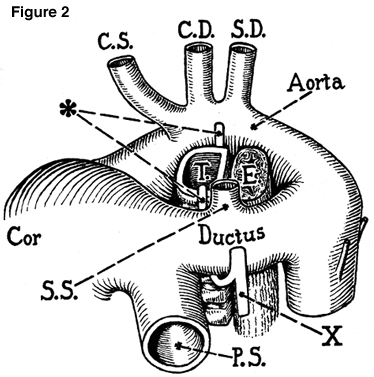

Illustrated Encyclopedia of Human Anatomic Variation: Opus II: Cardiovascular System
Ronald A. Bergman, PhD
Adel K. Afifi, MD, MS
Ryosuke Miyauchi, MD
Peer Review Status: Internally Peer Reviewed

Fig. 1Anterior view of the heart and great vessels. The pericardium has been cut away and the right ventricle opened by reflecting a portion of its wall. The right atrio-ventricular ostium is visible. Above this is seen the ventricular septal defect (the asterisk is within the aperture; the arrows are pointing to the edge), through which are visible the posterior (larger of the two) and the left aortic valves. The right and posterior pulmonary cusps are visible at the base of the pulmonary artery. The inferior laryngeal nerves are turning around their respective arches. The vein of the left atrium is seen arching over the left pulmonary artery and thence into a free pericardial fold (3/4 natural size).

Fig. 2 Drawings (1-1/3 natural size) of the great vessels from the left side and above. The trachea (T.) and esophagus (E.) have been transected close to the vascular arches. The branches of the right-sided aorta are: the left common carotid (C.S.), the right common carotid (C.D.), and the right subclavian (S.D.) arteries. The left subclavian artery (S.S.) arises from the mid-portion of the ductus arteriosus; the left pulmonary artery (P.S.) from its base. The inferior laryngeal nerves are indicated by an asterisk; the X labels the left vagus nerve.
from Siekert.
Section Top | Title Page
Please send us comments by filling out our Comment Form.
All contents copyright © 1995-2025 the Author(s) and Michael P. D'Alessandro, M.D. All rights reserved.
"Anatomy Atlases", the Anatomy Atlases logo, and "A digital library of anatomy information" are all Trademarks of Michael P. D'Alessandro, M.D.
Anatomy Atlases is funded in whole by Michael P. D'Alessandro, M.D. Advertising is not accepted.
Your personal information remains confidential and is not sold, leased, or given to any third party be they reliable or not.
The information contained in Anatomy Atlases is not a substitute for the medical care and advice of your physician. There may be variations in treatment that your physician may recommend based on individual facts and circumstances.
URL: http://www.anatomyatlases.org/